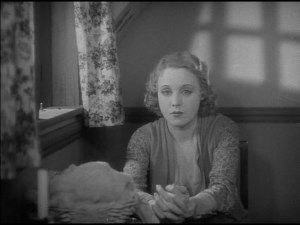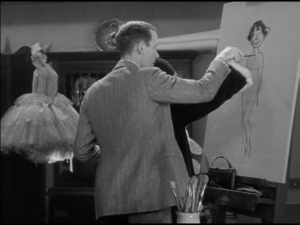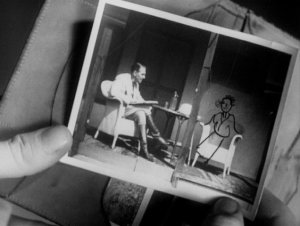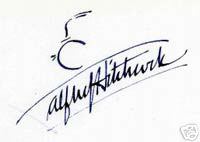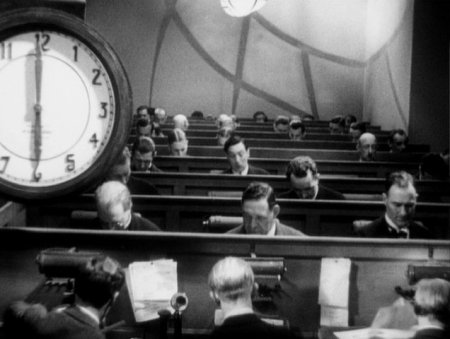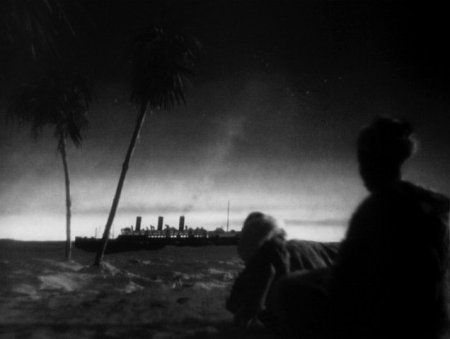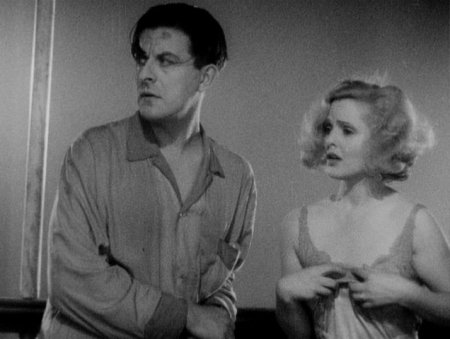
I watched the silent version of BLACKMAIL for the first time this week (it’s been ridiculously hard to see for most of my life). It ended just in time for me to catch Paul Merton Looks at Alfred Hitchcock on the telly (it was OK, very good in places, critically weak in others). Then I watched the talkie version of BLACKMAIL. Because I am hardcore.
I’m inclined to view BLACKMAIL (silent version) as Hitch’s second masterpiece, after THE LODGER, and it’s actually a more accomplished film than the earlier thriller. While the Ripperesque thrills in Hitchcock’s third movie were beautifully rendered shot by shot, the movie has bigger problems in plot terms, mainly caused by the need for Ivor Novello’s mysterious tenant to be found innocent at the end. BLACKMAIL also was supposed to have a very downbeat ending, and Hitch was forced to compromise once more, but the ambiguous and rather queasy conclusion he created with playwright Benn Levy (THE OLD DARK HOUSE) and, reportedly, an uncredited Michael Powell, is far more successful that THE LODGER’s fatuous story-book finish.
For what seems like the first time, Hitch has a story with both solid structure and a firm control of point-of-view. Basically, the story begins with plodding detective John Longden on a case, running to ground a hilariously stereotyped criminal degenerate, with the kind of Boris Karloff mug that would have been a gift to Lombroso. Then we shift from police procedural to social comedy as Hitchcock details the difficulty of getting a good table in a Lion’s Corner House with the same forensic attention he devoted to the interrogation and identification of a felon. This scene allows the POV to shift to Longden’s girl, Anny Ondra from THE MANXMAN.
Anny has covertly arranged to meet an artist, who lures her to his garret, plies her with drink and lewd song (in the sound version, at least), makes off with her dress and tries to –
“He tried to -” says Anny in the talkie version, proving that there are some places dialogue cannot yet go.

In a set-piece sequence, Anny stabs her assailant to death and flees the scene, having retrieved her dress but left behind a glove. Now the POV can shift back to Longden, called in to investigate the case. Recognising both the glove and the victim, he conceals evidence and confronts Anny, only to find himself in thrall to a sleazy blackmailer, played by Donald Calthrop (a good all-rounder with a special propensity for seediness — in SECRETS OF FP1 he plays a grubby reporter, a role taken by Peter Lorre in the German version). The scenes of blackmail take place in Anny’s home, resulting in a return of the domestic/criminal confluence Hitchcock had mined so successfully in THE LODGER, and which he would return to throughout his career, perhaps most notably in SHADOW OF A DOUBT.
Adding to the tension and tautness of the narration, Anny’s family run a newsagents, and they live a short distance from the crime scene, so that the murder is on everyone’s lips. The proximity of shop and kitchen also denies the family privacy, so that an annoying neighbour can natter on at them while they try to eat breakfast — a stand-out scene in the talking version (“Knife!”).
Still believing his girlfriend to be innocent (this essential character point is a little unclear, especially in the silent), Longden tries to shift the blame to Calthrop, who flees police by smashing through the newsagent window in a very strange manner, pressing his body up against the glass until it yields and he can slip through. It’s the least dynamic window-smashing I’ve ever seen, certainly compared to Lionel Stander’s very animated flying exit in HANGMEN ALSO DIE:

Lionel checks out.
Ducking into the British Museum, Calthrop is pursued through a range of extremely impressive special effects shots (the museum refused entry to Hitch and his crew) and falls to his death. The blame safely laid at the dead man’s door, Ondra is saved, but retains a haunted expression. Hitch had wanted to convict her, and end the film in a manner symmetrical with its beginning, but British International Pictures thought that was too depressing. The ending chosen is pretty unsettling though — without a confession, there can be no expiation of guilt.
Watching the silent version first, I was blown away by how good it is. Adapting a play by his future collaborator Charles Bennett, Hitch finds all manner of suspense-generating devices and visual tropes. Then, when I watched the talkie, my appreciation of it was raised. My most recent viewing of it had been rather unsatisfactory. My awareness that Anny Ondra was being dubbed by Joan Barry, sat just off-camera with her own microphone while Ondra moved her lips soundlessly, (see SINGIN’ IN THE RAIN for a good demonstration of this technique) was rather distracting. And Barry’s voice is not as appealing as Ondra’s — as impressive as Hitch’s invention of dubbing is — and done live! — Barry’s strange, over-enunciated version of cockney is unconvincing, and her voice rather grating. The effect is to rob Ondra of much of her innate eroticism (although in the talkie version, Hitch obligingly shows her stripping down to her slip while the lecherous artist serenades her on his grand piano — I did feel for the piano-movers who must have heaved it up the many floors to his attic suite).
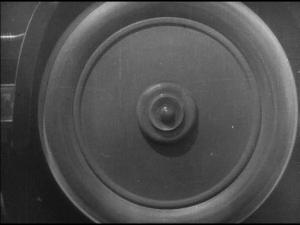
This graphic image IN NO WAY matches the wide shot of a speeding truck that follows it.
Starting with a spinning wheel — the wheel of justice! — Hitch shows a police van racing through London streets (with some very poor matte shots of the interior) and stopping in what must be the East End to make an arrest. We meet Longden and his superior, and glimpse a little black boy playing in the street. While making ethnic minorities visible is a good thing, his inclusion feels uncomfortably like a signifier that this is a bad area.
This sequence is identical in both versions of the film, with more or less constant music (by Hubert Bath of THE PASSING OF THE THIRD FLOOR BACK) to fill in the silence, and only the most minimal sonorization: there’s a footstep sound when the cops get out of their “black Maria” van, and then they continue noiselessly on their way, even making little comments to each other which we don’t hear. It’s not a problem, but it’s kind of strange and interesting.
When the cops enter the room where the degenerate old crim lies reading his paper in bed, there’s a beautiful pan from his face as he scans the room, spotting the cops reflected in a mirror, which leads him to reach for a gun. The cops nab him, and we follow his processing through the police station: fingerprinting, interrogation, identification (no messing about with one way glass here — the witness has to walk right up to him and lay a hand on his shoulder.
Enter Anny Ondra, voiced by Joan Barry in the talkie version. As Longden and Ondra go on their date (with Barry tagging along off-camera), the scene plays out more or less the same, even down to camera angles. The dialogue script contains a few more lines, however, and Hitch finds ways to make Ondra more sympathetic than in the silent — she nags her boyfriend and is dismissive of his job at Scotland Yard (“If it wasn’t for Edgar Wallace, nobody would ever have heard of you.”), but he’s grumpy too, and Hitch lessens the implication that she’s arranged to meet another man, as well as suggesting that she thinks better of the idea. But Longen walks out on her, and her fate is sealed.
Lured up to the artist’s studio, Ondra is followed up the stairs by an elegant crane shot, in a scene perhaps influenced by Borzage’s SEVENTH HEAVEN (or Keaton’s THE CAMERAMAN). In both versions, Hitch shows the artist with curling shadows falling on his face, apparently to mimic the curly moustaches of a villain in an old stage melodrama. The effect isn’t absolutely clear, but it is eerie and sort of disfiguring, so it works.

The shadow of that moustache would haunt actor Cyril Ritchard throughout his life — his most celebrated stage role was as Captain Hook, opposite Mary Martin in Peter Pan.
When the nasty artist attempts to subject Ondra to his depraved appetites, Hitch stages a simple but dramatic set-piece: the struggle behind the curtain. Ondra’s hand reaches out and grabs the convenient knife, the curtain flutters some more, and then the artist’s hand drops into view, lifeless. Ondra emerges, a look of madness in her face. But she’s sane enough to at least try to remove all evidence of her presence in the flat. As she flees into the night, we get this great shot of the blackmailer’s arrival, echoing Ivor Novello’s appearance in THE LODGER a few years earlier.

Ondra wanders the streets, distraught, allowing Hitch to play with a variety of subjective effects, some slightly crazy, like the neon sign that transforms into a memory of murder, some very elegant: a shot of the Big Ben clock tower, telling us the time, is followed by an extreme high angle looking down at London from the sky — the God’s-eye-view that returns, strikingly, in THE BIRDS, more than 30 years later. Other ideas, like the neon sign that mutates into a nightmare image, don’t do much beyond showing off the fertility of Hitch’s imagination.
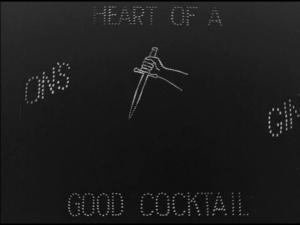
A Hitchcocktail?
In the silent version, oblivious passers-by flit past Ondra in a lateral tracking shot, while in the talkie, their numbers are augmented by double-exposed transparent shades, suggesting a much longer and more mentally confused walk. A shot of a traffic policeman’s hand triggers a quick cut back in time to the slain man’s hand, which is very effective, but even more impressive is the moment when a shot of the corpsefingers is inserted BEFORE a shot of a sleeping tramp’s hand. It’s an odd, counter-intuitive way of making the connection, but it works, and is much more startling.
Now comes the central sequence at Anny’s home, above a newsagent’s. Dublin-born Sara Allgood, who would get a major role in Hitch’s next talkie, plays Annie’s mum. I guess her Irish accent would have been irrelevant in the silent version, but it becomes an interesting detail in the talkie. Here, as in SABOTAGE, we get a strong sense of the pressure of running a business that’s attached to your own home. The family are deprived of pivacy as they attempt to have breakfast, being bothered both by a nosy neighbour and by the constant ringing of the shop door-bell, calling them to serve customers. Hitch again finds he can use ordinary domestic life to heighten the suspense of a thriller situation.
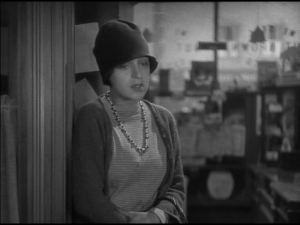
Silent “knife.”

Talkie “knife”. Presumably, the young lady in the first version couldn’t do a cockney accent, and Hitch must have had second thoughts about her costume. She’s the biggest change in the sound “remake”. Apart from the sound.
This is of course a major sequence in the talkie, the “knife” dialogue, in which the moaning neighbour’s monologue slowly fades to a murmur, except for the repeated word “knife”, which gets louder and louder. It also seems to turn up in the conversation an awful lot. Sound man Dallas Bower recorded the wild track upon the producer’s request, unsure if Hitch really knew what was going on, but I bet it was Hitch’s idea in the first place — it’s an audio version of the kind of subjective effects he was attempting in all of his silent films. Perhaps he didn’t understand the technical details of recording it, but he must have known what the aim was.
Meanwhile, the body has been discovered, via a beautiful sound link (Ondra looks startled at home, and we cut to the landlady screaming), and Longden has answered the call to the crime scene, where he finds Ondra’s glove. He’s about to report it when he recognises the murder victim — via a very fast track-in of the kind Hitch had already deployed in CHAMPAGNE, for example — as the man he saw with Ondra. He pockets the glove and goes to see her.
Now Donald Calthrop comes into his own as the blackmailer, with another of those odd posh cockney accents of the kind frequently spoofed by comedian Harry Enfield. But he’s very effective, and the sound version even manages to make him sympathetic when the tables are turned, deepening the film’s moral ambiguity. Hitchcock was already learning that in a talkie, the primitive power of visual storytelling can be given an additional layer of sophistication by the dialogue. While stressing the primacy of the image, Hitch would always seek to enhance his films with witty and literate writing.
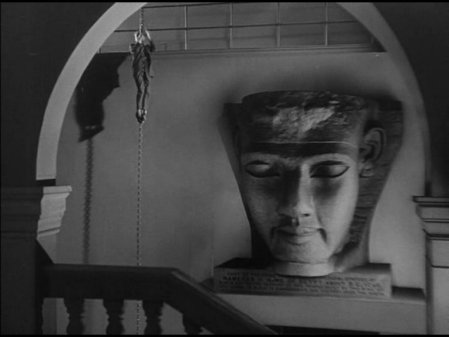
Calthrop’s flight into the British Museum was apparently the suggestion of Michael Powell, a habitue of the library. Years later, Charles Bennett, author of the original source play, would have Dana Andrews visit the same reading room in NIGHT OF THE DEMON. But the climax is slightly unsatisfactory — the museum has no connection to the story, or to Calthrop’s character, and he has no particular reason to go there. This kind of arbitrary climax is a common occurrence in British Hitchcock movies, which are looser in construction and more likely to throw in gratuitous action sequences than the later American productions, which are more structured (exceptions will be noted). But I liked the constant cutaways to Ondra at home, more or less praying for release, with the window shadows behind her not quite creating a crucifix shape. It prefigures Henry Fonda’s answered prayer in THE WRONG MAN.
Of course, Ondra’s prayer is answered by Calthrop falling to his death, which allows the police to close the case, blaming him for the killing she committed. The Production Code would never have allowed such an immoral ending, but Hitch is almost happy to allow Ondra off the hook — she was only defending herself, after all. But as she confesses her guilt to Longden, and they agree to keep it their secret, Hitch shows the dead artist’s mutilated painting being carried into the station house. Ondra’s expression upon seeing it is one of horror. There’s no hint that the painting is a clue that will unmask her as the killer, but it is a reminder of what she’s done, and the fact that she can never escape that.
While the silent BLACKMAIL is more accomplished than the hastily repurposed talkie, the sound version does add several memorable effects, and is a model example of how a film can use sound intelligently without being overtaken by dialogue. It basically plays as an audio-visual experience with a few talking scenes. It would take Hitchcock some time to get back to that kind of purity, because his next films are theatrically derived, dialogue-driven, and in many ways quite uncharacteristic…
